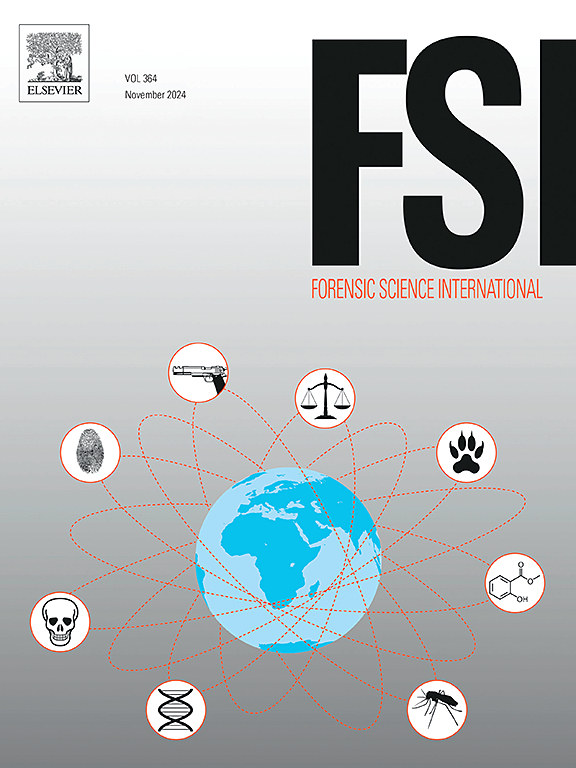2016年至2022年芬兰南部法医尸检中神经病理学咨询的分类和意义
IF 2.2
3区 医学
Q1 MEDICINE, LEGAL
引用次数: 0
摘要
一般法医病理学家和神经病理学专家之间熟练的咨询实践可能在法医死因调查中证明是有价值的。关于目前在法医尸检中使用神经病理学咨询的详细数据很少。这项基于登记的回顾性研究的目的是提供2016-2022年芬兰南部与神经病理学咨询相关的法医尸检病例的细分。向芬兰卫生和福利研究所法医股的电子信息系统查询了在赫尔辛基办事处进行了法医解剖并由神经病理学顾问进行了神经病理学检查的案件。收集了大量病例的详细特征,并评估了病例神经病理学咨询的总体意义。统计方法是描述性的。在研究期间,共进行了216例法医尸检,并进行了神经病理学咨询。大多数病例涉及男性后代(68.5 %;死亡年龄0-96岁)。创伤性脑损伤是最常见的会诊主题(45.4% %),其次是癫痫(18.1% %)、缺氧缺血(14.8% %)和神经退行性疾病(14.8% %)。两个最常报道的结果是缺氧缺血性损伤(76.4 %;通常为轻度和晚期)和脑水肿(36.6 %)。在大多数情况下,咨询可能指导选择潜在的死亡原因(64.8% %),在三分之一的情况下还指导选择死亡方式(32.4% %)。此外,大多数会诊向法医病理学家提供了与案件相关的其他信息(67.6% %)。综上所述,近年来,芬兰南部的神经病理学咨询实践显然使法医死因调查受益。描述性和比较分析的神经病理学实践在其他医疗法律机构是必要的。本文章由计算机程序翻译,如有差异,请以英文原文为准。
Breakdown and significance of neuropathology consultations in medico-legal autopsies in Southern Finland between 2016 and 2022
Proficient consultation practices between a general forensic pathologist and a neuropathology specialist may prove valuable in medico-legal cause-of-death investigation. Detailed data on the current use of neuropathology consultations in medico-legal autopsies are scarce. The aim of this retrospective register-based study was to provide a breakdown of medico-legal autopsy cases associated with a neuropathology consultation in Southern Finland over the period 2016—2022. An electronic information system of the Forensic Medicine Unit, Finnish Institute for Health and Welfare, was queried for cases that underwent a medico-legal autopsy at the Helsinki office and had a neuropathological examination performed by a consultant neuropathologist. Numerous detailed characteristics of the cases were collected, and the overall significance of neuropathology consultation for the cases was assessed. The statistical approach was descriptive. A total of 216 medico-legal autopsies with a neuropathology consultation were performed over the study period. Most cases involved a full neuropathological examination (97.7 %) of a male decendent (68.5 %; age at death 0—96 years). Traumatic brain injury was the most frequent consultation theme (45.4 %), followed by epilepsy (18.1 %), hypoxia-ischaemia (14.8 %), and neurodegeneration (14.8 %). Two most often reported findings were hypoxic-ischaemic injury (76.4 %; often mild and terminal) and cerebral oedema (36.6 %). In the majority of cases, the consultation was likely to guide the selection of the underlying cause of death (64.8 %), and in a third of cases also the manner of death (32.4 %). In addition, most consultations provided the forensic pathologist with other information that was considered significant for the case (67.6 %). In conclusion, medico-legal cause-of-death investigations have clearly benefited from the neuropathology consultation practice in Southern Finland over the recent years. Descriptive and comparative analyses of neuropathology practices in other medico-legal institutions are warranted.
求助全文
通过发布文献求助,成功后即可免费获取论文全文。
去求助
来源期刊

Forensic science international
医学-医学:法
CiteScore
5.00
自引率
9.10%
发文量
285
审稿时长
49 days
期刊介绍:
Forensic Science International is the flagship journal in the prestigious Forensic Science International family, publishing the most innovative, cutting-edge, and influential contributions across the forensic sciences. Fields include: forensic pathology and histochemistry, chemistry, biochemistry and toxicology, biology, serology, odontology, psychiatry, anthropology, digital forensics, the physical sciences, firearms, and document examination, as well as investigations of value to public health in its broadest sense, and the important marginal area where science and medicine interact with the law.
The journal publishes:
Case Reports
Commentaries
Letters to the Editor
Original Research Papers (Regular Papers)
Rapid Communications
Review Articles
Technical Notes.
 求助内容:
求助内容: 应助结果提醒方式:
应助结果提醒方式:


